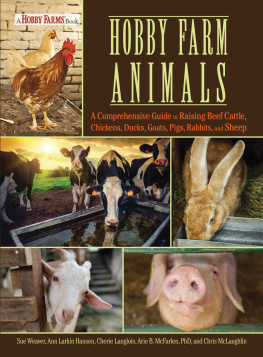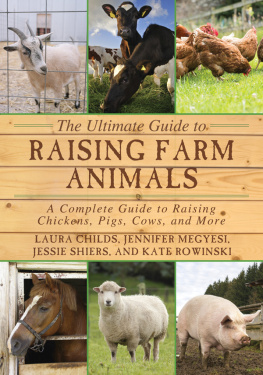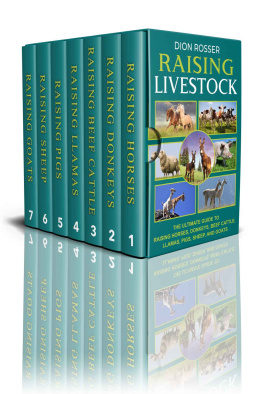STOREYS GUIDE TO RAISING MINIATURE LIVESTOCK
Storeys Guide to
RAISING MINIATURE LIVESTOCK
Health Handling Breeding

Sue Weaver

The mission of Storey Publishing is to serve our customers
by publishing practical information that encourages
personal independence in harmony with the environment.
Edited by Sarah Guare and Deborah Burns
Art direction and book design by Cynthia N. McFarland
Cover design by Kent Lew
Text production by Erin Dawson
Cover photograph by Jason Houston
Interior photography credits appear on page 452
Illustrations by Elayne Sears
Indexed by Christine R. Lindemer, Boston Road Communications
2010 by Sue Ann Weaver
All rights reserved. No part of this book may be reproduced without written permission from the publisher, except by a reviewer who may quote brief passages or reproduce illustrations in a review with appropriate credits; nor may any part of this book be reproduced, stored in a retrieval system, or transmitted in any form or by any means electronic, mechanical, photocopying, recording, or other without written permission from the publisher.
The information in this book is true and complete to the best of our knowledge. All recommendations are made without guarantee on the part of the author or Storey Publishing. The author and publisher disclaim any liability in connection with the use of this information.
Storey books are available for special premium and promotional uses and for customized editions. For further information, please call 1-800-793-9396.
Storey Publishing
210 MASS MoCA Way
North Adams, MA 01247
www.storey.com
Printed in the United States by Versa Press
10 9 8 7 6 5 4 3 2 1
LIBRARY OF CONGRESS CATALOGING-IN-PUBLICATION DATA
Weaver, Sue.
Storeys guide to raising miniature livestock / by Sue Weaver.
p. cm.
Includes index.
ISBN 978-1-60342-481-3 (pbk. : alk. paper)
ISBN 978-1-60342-482-0 (hardcover : alk. paper)
1. Miniature livestock. I. Title. II. Title: Raising miniature livestock.
SF61.W24 2010
636dc22
2009041819
To Gib and Melba Mullins
of Ridgerunner Miniature Horses in Caulfield, Missouri,
who raise the best little horses in the world.
Thanks for your friendship, guys!
Contents
Why Raise Miniature Livestock?
ASK A HOST OF ESTABLISHED HOBBY FARMERS and most will agree that there is little (if any) money to be made in commercial, full-size livestock. Feeder cattle, market hogs, and standard lamb-and-wool operations are faltering. With the cost of keeping farm animals hurtling skyward, steadily increasing numbers of owners and producers are turning to raising smaller breeds of livestock, and wisely so. Miniature livestock require less housing space, pasture, fencing, and feed than do their full-size counterparts. According to American Miniature Horse Association figures, you can feed, house, and maintain five miniatures for the cost of keeping a single standard-size horse. Beef cattlemen can stock two or three miniature Herefords or Lowline Angus to one garden-variety cow (Hereford, Angus, Holstein). And a pair of miniature sheep or goats or even a pig can lodge happily in a doghouse in a fenced backyard.
Minis are easier to handle and less intimidating than commonplace livestock, especially for beginners, children, old folks, and the physically challenged, not only due to their smaller stature but also because many miniatures are specifically bred for calm disposition and tractability. Chores such as hoof trimming, shearing or clipping, giving shots, and administering dewormers are infinitely easier, as is training peewee livestock for show or pleasure.
In most states, keeping miniature livestock (especially cattle and heritage pigs, often goats and sheep, but rarely equines) qualifies landowners for valuable agricultural-use land tax exemptions, even on relatively small parcels of land. And minis are sometimes acceptable where zoning laws prohibit full-size barnyard pets.
Enthusiasts exhibit pint-size livestock and poultry at species-specific shows, state and county fairs, and as 4-H projects. Most species are locally transportable in a van or SUV. Scaled-down equines, cattle, goats, and llamas handily pull carts and wagons, even with adults at the reins. Country kids dress their mini friends in costume for the kiddies day parade.
MINIATURE LIVESTOCK: WHATS THAT?
There are three kinds of miniature livestock. For this books purposes well refer to all three groups as miniature livestock, though owners of traditional breeds in the first two groups are quick to point out that their favorite breeds werent miniaturized by man.
 Naturally diminutive breeds that evolved as small animals to better survive the conditions nature handed them. Think Soay sheep, San Clemente Island goats, and British Shetland ponies.
Naturally diminutive breeds that evolved as small animals to better survive the conditions nature handed them. Think Soay sheep, San Clemente Island goats, and British Shetland ponies.
 Small breeds that retained their original breed character when their parent breeds were selected for greater size. These include Miniature Jersey cattle and Babydoll Southdown sheep.
Small breeds that retained their original breed character when their parent breeds were selected for greater size. These include Miniature Jersey cattle and Babydoll Southdown sheep.
 Breeds that were deliberately miniaturized by breeders who selected for smaller stature, often through outcrossing to an established smaller breed. Miniature Highland and Miniature Longhorn cattle spring to mind.
Breeds that were deliberately miniaturized by breeders who selected for smaller stature, often through outcrossing to an established smaller breed. Miniature Highland and Miniature Longhorn cattle spring to mind.
Minis irresistible cute appeal and their easygoing natures make them unrivaled tagalongs for nursing home, school, and hospital visitations. What better traffic-stopper than a 30-inch pint-size Zebu bull; an 18-pound miniature horse foal; or a teensy Pygmy goat kid. Minis are fun to own!
And the bottom line: Quality miniatures tend to pay their way. Miniatures cost less to raise, and because they are in short supply, a ready market awaits the conscientious breeder. They can fetch good money at annual sales. And customers tend to pay a premium for value-added products in lieu of the usual kind (goat cheese or yogurt, handspun yarn, and heritage beef or pork). If you want to raise livestock and show a profit (or at least break even), think small! This is the best time in history to invest in miniature cattle, horses, donkeys, mules, sheep, goats, and llamas: breeders abound, and they are eager to welcome newcomers into the fold. Breeders on one side of the United States can easily ship miniature lambs, kids, and piglets by air, two to a standard large-size dog crate.
Whether youre considering a pair of miniature fiber llamas, a herd of meaty Lowline cattle, or a flock of tiny sheep, this book is designed to help you find, select, buy, and take good care of your tiny charges, and if you wish, market them to others who would like to do the same.
SECTION 1
Raising Miniature Livestock
1
Before You Begin
BEFORE LAUNCHING any animal-related enterprise, be certain you understand its demands. Raising animals will impact your lifestyle, your physical and emotional health (typically for the better), and your bank account. Not everyone is cut out to keep livestock, however, miniature or otherwise. Are you?
Lifestyle Choices
Are you willing to be on call 24 hours a day, 7 days a week, 365 days a year, whenever your livestock need you? Will you camp in the barn when foals are due? Roll out of bed at two in the morning to feed a bottle lamb? Retrieve errant cattle and patch their flattened fences under a noonday sun, missing that long-anticipated televised ball game in the process? Animals rarely get hungry, sick, loose, or injured at convenient times.
Next page







 Naturally diminutive breeds that evolved as small animals to better survive the conditions nature handed them. Think Soay sheep, San Clemente Island goats, and British Shetland ponies.
Naturally diminutive breeds that evolved as small animals to better survive the conditions nature handed them. Think Soay sheep, San Clemente Island goats, and British Shetland ponies.